Despite the best hearing instruments, most hearing-impaired listeners notice they have difficulty hearing in certain situations. Understanding speech in the presence of noise (with or without hearing instruments) is one of the most common problems hearing impaired individuals face. Most audiologists know this to be true anecdotally, and it has been confirmed in several consumer satisfaction studies.
Sergei Kochkin's 1994 study found that 74% of hearing aid wearers were disappointed with the performance of their hearing instruments in noisy situations. Several studies have shown correlations between poor hearing instrument performance in noise and non-ownership of hearing instruments by people with hearing impairment, failure to use hearing instruments regularly, and a low percentage of users who are satisfied with the performance of their instruments in multiple listening environments. In 1997, Stock, et al, asked consumers to provide hearing instrument manufacturers with suggestions on how the instruments could be improved. Eighty-seven percent of the responses noted that the top priority was to improve speech intelligibility in noise.
Noise is defined as any signal other than what the hearing instrument user wishes to hear. Noise is particularly annoying when it interferes with speech. Of course, the annoyance level is related to the signal-to-noise (SN) ratio. As the SN ratio decreases, the annoyance, and the difficulty understanding speech increase. Four major factors influence the Signal-to-
Noise Ratio and thus the quality of the speech signal. These are hearing loss, background noise, reverberation and distance.
People with sensorineural hearing loss need a more favorable signal-to-noise ratio to understand speech than do normal hearing listeners. Research has shown that hearing impaired listeners may require signal-to-noise improvements of 4 dB to 18 dB, depending on the magnitude of their hearing loss to achieve word-recognition scores equivalent to those with normal hearing.
FM systems are able to improve the signal-to-noise ratio. FM systems improve the user's ability to understand speech in the presence of noise. Since the sound is delivered by FM radio waves, the strength and quality of the sound remains constant (across the operational distance) from the speaker to the hearing impaired individual. FM systems consist of a microphone usually placed four to six inches from the sound source, and a transmitter, which sends the signal via radio waves directly to the miniature FM receiver, which is connected to the personal hearing instrument. In other words, the entire FM system is a complete broadcasting and receiving system.
Importantly, when using FM systems, the effects of background noise and reverberation are minimal. These factors help reduce background noise while enhancing and stabilizing the main sound source.
It is easy to be impressed by FM technology. However, it is important to ask probing questions regarding the features and quality of all FM and other assistive listening devices. Audiologists and dispensers must learn to use the equipment and become familiar with the operation of today's FM systems. Below are 10 sample questions, which may help determine the desirability and necessity of the device under consideration.
Sample Questions to Determine ALD Suitability.
1- Performance- Does it work efficiently and effectively? Is it easy to learn to use this device? Is it compatible with other devices? Does this device serve only one purpose or is it flexible?
2- Elegance- Does this device represent the simplest, most efficient way to accomplish the task? Is this device too elaborate, too complicated to be worthwhile?
3-Ergonomics- Does it fit the individual? Is it convenient to use in the environment? Is the product portable enough to go where the user goes? Are different devices needed in different environments?
4-Reliability- What is the manufacturer's reputation for reliability? Does it stand up well to normal use? Is it durable? What is the warranty?
5-Safety- What is the power source for the device? Is a margin built in for foreseeable misuse?
6- Practicality- Do the sales and service people seem knowledgeable and helpful? How available are repair services? Cost? Can this device be leased? Is this device available for a trial period before purchase? Will this device soon be outdated? Is something better on the horizon? Will the company update the device? Does the manufacturer provide training in using the device?
7- Aesthetics- Is this device attractive to the eye? Does the device fit well into the user's lifestyle?
8- Normalization- Does the device assist the user in approaching normalized living? Can the user operate the device independently or with a minimum of assistance? Does the device 'stick out' too much and advertise the disability of the user? Does the equipment minimize difference or exaggerate difference? Does the device have the potential to increase the quantity and quality of time spent with non-disabled peers or does the device separate the user from others?
9- Cost effectiveness- Do the benefits the device provides justify the cost? Are there less expensive devices or models that serve the purpose as well?
10- Personal acceptance- Is this device the user's own choice? Does the potential user like this device and want to use it? Does the potential user view this device as life-enhancing? Would the user have preferred some other device or means to perform the task? Will using the device always be a chore or can using it become a habit?
After identifying a device that appears to meet the user's needs, try the device out to make sure it performs as expected and fits in well with the user's lifestyle. Usually a week is sufficient for an ALD, although FM systems, like hearing aids, may require 30 days. During the trial period, one can usually identify training needs for the user, family members and school staff. The trial period will also be a time for the user to test the device in several settings to determine its portability and flexibility. In some ways, an ALD becomes an extension of the user's mind and body. It is a highly personal item. A device may work as advertised, but still not meet an individual's needs because the individual just does not feel 'comfortable' using it.
After the assistive listening device has been purchased and put to use, there are additional follow-up activities that should take place. At first, ALDs may seem to exaggerate differences between a hearing impaired person and the rest of the world. Care should be taken to explain that the ALD is a difference equalizer, not a difference maker. This is of particular importance with children. Classmates and friends need to understand that the ALD helps the individual hear what other students hear. People need to know that ALDs help keep individuals with hearing disabilities from being separated from peers.
Close communication between parents and their child's helpers--teachers, therapists, day care workers and others--is essential to make sure devices and services are being used safely and effectively. If the device is working well, but the child is not being integrated into the classroom or other environments, there may be a need for additional training for the children and adults who interact with the child.
It may be advantageous for ALD information to be shared with the student's peers. Such training will often help fellow students gain an understanding of the student's ALD, foster acceptance in the social environment, and reduce fears other students may have about socializing with the student who uses technology. In some cases, parents and the student may want to be involved in 'peer training.'
Most importantly, the student himself or herself, will need training in how to use the device as independently as possible. Training for the ALD student may be written into the IEP as a separate goal or may be included as a related service that supports the student's special education program.
FM FAQS:
Phonak FM systems operate on an FM radio signal in the 216-217 MHz bands. These bands have been assigned by the FCC for use with equipment by the hard of hearing. There are 23 narrow band channels available from Phonak in this frequency range. In order for the transmitter and receiver to operate as a system, they must be on the same frequency or 'channel'. All Phonak FM transmitters and receivers are compatible with every other model of transmitter and receiver in the Phonak product line. Each transmitter and receiver channel 'frequency' is identified with a number. The number of the transmitter and FM receiver must be the same for these units to function together correctly.
FM Transmitters and FM Receivers are available in many sizes and shapes to offer increased functionality. We will detail some of the Phonak equipment below:
FM TRANSMITTERS:
1- MicroVox TX2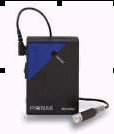
The MicroVox TX2 is a small and lightweight FM transmitter with a lapel microphone. The transmitter is worn by the speaker, making the MicroVox a good product for applications in school, in lectures, or in conversations between two persons. The MicroVox TX2 is normally clipped to the belt. The microphone is positioned 15 to 20 centimeters (6 to 8 inches) from the speaker's mouth or sound source.
2- HandyMic TX3 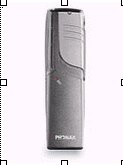
The microphone with a built-in transmitter, used primarily for adults. The multi-microphone technology of the HandyMic combines omni directional, directional, and super directional microphones with an FM transmitter. The compact HandyMic transmits the speaker's voice directly to the hearing instrument user's FM receiver.
The HandyMic can be set up directly in front of the sound source, slipped into the speaker's shirt pocket, or aimed at the speaker manually. With an audio cable, the HandyMic can also be connected to a sound system. As with all other Phonak FM products, the HandyMic has a range of 7 to 15 meters (23 to 50 feet).
3- Campus S - Available November 2001
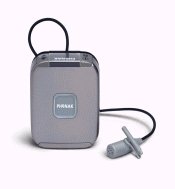
The Phonak Campus S is a new addition to the Phonak product line - this multi-channel FM transmitter is developed for use in schools, universities and speech therapy. It is fully compatible with current Phonak FM products, and ready for operation with future generations of Phonak FM receivers.
Campus S special features include a channel selector with digital display, an ergonomic user interface, a microphone with switchable directional / omni directional characteristics, handy storage for the microphone cable, connection to televisions, video recorders and radios, and an easily exchanged rechargeable battery.
4- TelCom

Phonak's TelCom is a stationary FM transmitter that allows optimized television, telephone, and audio system usage. While the user watches TV or listens to music, TelCom assures that the telephone will be heard when it rings. When the call is answered, TelCom automatically mutes the audio signal and transmits the caller's voice to the FM receiver. This does not affect the volume of the loudspeakers for others in the room. When the handset is replaced, the audio signal transmitted to the hearing instruments is returned to the previous volume setting. TelCom is equipped with a frequency synthesizer for convenient setting of FM frequencies; it has a range of 7 to 15 meters (23 to 50 feet).
FM Receivers
1- MicroLink ML3-7
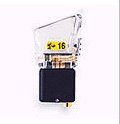
MicroLink is the smallest FM receiver available on the market today. It is integrated in an audio shoe that simply clips on to the hearing instrument. It can remain locked in place or removed again in seconds. AFC (automatic frequency control) effectively prevents distortion. The soft-squelch system suppresses noise. The ML7 FM receiver features the ability to easily switch between numerous frequency channels. The MicroLink receivers are compatible with all Phonak BTE instruments.
2- MicroLink MLx

This miniature FM receiver is compatible with all Phonak BTE instruments and has a standardized Euro connector that allows it to be used with most other makes of BTE hearing aids on the market today. Many leading hearing aid manufacturers such as Oticon, GN Resound, Siemens, Sonic Innovations, Unitron, and Widex have developed mechanical interfaces that allow users to combine their BTEs with MicroLink MLx. This close cooperation with other major hearing instrument manufacturers has dramatically expanded FM benefits for hearing-impaired children and adults.
The small, cubed-shaped MicroLink MLx attaches directly to the base of the audio shoe and receives FM signals from all Phonak wireless transmitters. The MLx 'Universal' FM receiver has a three-position switch. The three-position switch allows the MLx user to change the function of the wireless receiver as listening conditions change.
When the MLx switch is set to the 'two dot' position, this is called the FM+M position. The signal from the transmitter and the signal from the hearing instrument microphone are equally loud. When the MLx switch is set to the 'single dot' position, this is called the FM priority position. The signal from the transmitter is 20 dB louder than the signal from the hearing instrument microphone. This position is used in situations when the user only wants to listen to the signal coming into the wireless transmitter microphone.
When the MLx switch is set to the 'open dot' position, the FM signal is switched off and the hearing instrument microphone is still active.
Several hearing instruments offer the option to choose individually tailored MicroLink Programs. Many hearing instruments use remote controls or require special programming to activate the 'direct audio input' circuitry, which allows the MicroLink FM input into these hearing instruments.
3- MicroVox RX2 COM-1
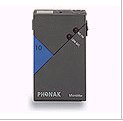
The MicroVox RX2 COM-1 is a small and lightweight FM receiver. With the COM-1 audio interface, the connection of an induction loop is very simple. The loop is worn around the neck, and the hearing aids receive the signal inductively via the telephone coil. A special feature of the MicroVox RX2 COM-1 is that it can also be connected to the audio input of the speech processor in a cochlea implant. Most implant manufacturers use compatible audio inputs.
4- MicroVox RX2 PFM-1

This FM receiver has a direct output for hearing instruments so it can be connected to the audio shoes of Phonak BTEs and other BTE instrument makes. Like the COM-1, this FM receiver has easily interchangeable plug-in frequency modules. The color-coded frequency identification is a simple way to verify the receiver's frequency.
5- Claro dAZ FM
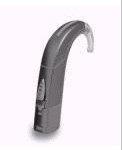
Claro dAZ FM combines two highly advanced systems for signal processing and signal reception. The Signal-to-Noise Ratio is dramatically improved with Digital Perception Processing, Adaptive digital AudioZoom, the Fine-scale Noise Canceler, and Phonak's FM technology. The FM functions can be controlled directly at the instrument with the TacTronic switch or with the SoundPilot FM or WatchPilot remote controls.
Watch Pilot Remote Controls
The remote control on the wrist
The remote control WatchPilot for Claro hearing systems is the first ever to be integrated in a wristwatch.

Functions:
+ AutoSelect
+ 2 FM functions
Summary
Purchasing a high tech ALD is a major life decision because of the potential impact on the individual and because such devices can be costly. When evaluating a particular product, consideration should be given to the following features: performance, simplicity of design, ergonomics, reliability, safety, practicality, aesthetics, normalization, cost effectiveness, and personal acceptance. Good sources of information about ALDs are manufacturer's publications, trade journals, preview centers, and consumers who are already using the device. The variety and applicability of FM receivers and transmitters are vast.
REFERENCES:
Kochkin S: MarkeTrak III: Why 20 million in U.S. don't use hearing aids for their hearing loss. Hearing Journal 1994; 46 (1): 20-27; 46 (2): 26-31; 46 (4): 36-37
Stock A, Fichtl E & Heller O: Comparing determinants of hearing instrument satisfaction in Germany and the United States. In S. Kochkin & K. Strom's (eds) High Performance Hearing Solutions, Vol. 2, Supplement to Nov. 1997 Hearing Review: 40-46
Hawkins D. 'Comparisons of speech recognition in noise by mildly-to-moderately hearing- impaired children using hearing aids and FM systems'. Journal of Sp and Hear Dis 1984, 49, 409-418.
Hawkins DB, Yacullo WS: Signal-to-Noise ratio advantage of binaural hearing aids and directional microphones under different levels of reverberation. J Sp Hear Dis 1984; 49:278-286.
For more information on Phonak click here.
Click here to visit the Phonak website.

